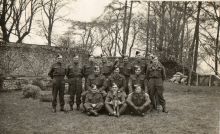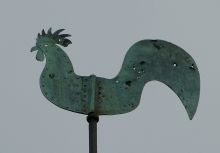The Sussex Scout Sections were divided geographically, with the Royal Sussex Regiment covering the west of Sussex. As in Kent, the section was known as XII Corps Observation Unit.
The Scout Section was made of Regular Army soldiers with a Lieutenant in command. Their role was train the Home Guard Patrols, but also to go to ground themselves in the event of an invasion.
The men were mostly recruited from the regimental depot at Chichester, though Sidney Gaston came from a detachment at Herne Bay.
The newly formed Section went to Coleshill House for a fortnight for initial training. They were based in the Old Rectory at South Stoke.
The section trained around the Rectory, including using the outbuildings of South Stoke Farm and once the farmhouse itself. They used blank ammunition though this tended to upset the animals. Elsie Lee described the soldiers as getting "very excited" with this mock combat. At other times they seemed very bored and she described them lying between the railway tracks and letting trains pass over them for kicks.
One very cold day the men were practising crossing the river on wires when one of the men fell in. He was brought back to South Stoke Farm to warm up, recalled Elise Lee, who lived adjacent South Stoke Farm. Their resident Italian PoW helped with this.
Targets included Ford Airfield, Poling radar station and Tangmere airfield, where Sid Gaston had a petrol dump as his target. On one exercise they pasted labels to the tails of the planes to prove they had been able to sneak into Tangmere. The next day the labels could still be seen as the planes taxied across the airfield to take off. They chose the tail as a small amount of plastic carefully placed could wreck the plane as effectively as a much larger charge elsewhere. At Poling they tied blocks of wood around the radar mast pylons in lieu of real explosives.
They also laid series of pipe mines, intended to create long furrows in aircraft or glider landing grounds. One of these, near Goodwood airfield, was discovered many years later resulting in Bomb Disposal troops being called. The press blamed the Canadian troops posted there during the war, but it had been the Scout Section.
The railway line running alongside the river Arun was also known to be a target.
Sometimes the Intelligence Officer would visit South Stoke from his Tottington HQ. Sid Gaston remembers him being informed of people who possibly had seen too much - who later seemed to disappear!
It doesn’t appear that any of the men subsequently joined the SAS from available records, unlike many of the other Scout Sections. Possibly this was because so many men of the Royal Sussex were posted overseas in 1943, mainly to the Middle East, after the Scout Section was disbanded. Others including most of the 2nd Battalion and volunteers from the 4th and 5th Battalion formed the 10th Battalion of the Parachute Regiment and that might have attracted the former Scout Section men.
The section had three separate Operational Bases (OB).
The best was in Arundel Park, just beyond the Black Rabbit pub on the way to Offham. It was linked to an Observation Post (OP) in a chalk put just behind the pub, with views of the river and railway. Being built early in the war, it was built from timber and flat sheets of corrugated iron. According to Les Hawkins, it was 20 feet long, 10 feet wide and 8 feet high. The floor was made of brick laid on a base of sand to provide good drainage. The roof was wood and corrugated iron, lined with wooden matchboard (interlocking planking). The roof was supported on pine struts, cut from local trees. There was a lifting trapdoor and the brick steps down into the OB. It also had a 30 foot concrete escape tunnel. The finishing touch was electric lighting powered from a car battery.
The earliest OB was dug into the chalk in a wood on Camp Hill, east of Amberley station. Initially two holes were sunk around 15 feet apart. Then Pat Darcy, who came from a mining background, dug out the chalk between by hand. This meant the ground was undisturbed on the surface. The result was 12 feet long, 10 feet wide and tall enough to stand up in. The chalk spoil was scattered through the wood, disguised with leaf litter and soil so it wouldn't be obvious from the air. There was also an associated OP, which was a covered slit trench about half a mile west on the edge of a chalk pit.
The third OB was built mid war and was described by Les Hawkins as an over sized Anderson shelter, made for heavy gauge corrugated iron. This sounds like one of the smaller elephant shelters. It was located near to Lavant, north of Chichester.
The Scout Section also helped in the construction of OBs for some of the Home Guard Patrols in their area. Although the Staplefield OB was constructed by Canadians, the Scout Section had to backfill the hole. They also camouflaged the ventilation pipes as rabbit holes, with real rabbit droppings for effect! They also helped build the Clapham OB and OP.
Both Les Hawkins and Sidney Gaston also recalled helping with the construction of Special Duties hides at Arundel and Bury.
| Name | Occupation | Posted from | Until |
|---|---|---|---|
| Lieutenant Gilbert Roy Fazan | Accountant |
18 Jan 1941 | 21 Jun 1943 |
| Corporal Jack Duffield | 1940 | 1943 | |
| Lance Corporal Les Hawkins | Unknown | 03 Dec 1944 | |
| Driver IC Jack Dempsey | Unknown | 03 Dec 1944 | |
| Driver IC Burt Libbeter | Unknown | 03 Dec 1944 | |
| Driver IC Gerald Savage | Unknown | 03 Dec 1944 | |
| Private George Collis | Unknown | 03 Dec 1944 | |
| Private Ron Dodds | Unknown | 03 Dec 1944 | |
| Private Terence Patrick “Pat” D’Arcy | Unknown | 03 Dec 1944 | |
| Private Sidney Gaston | Unknown | 03 Dec 1944 | |
| Private Leslie Robert Kennard | Head kennel man |
Unknown | 03 Dec 1944 |
| Private Bill Muschin | Unknown | 03 Dec 1944 | |
| Private John W. Paul | Unknown | 03 Dec 1944 | |
| Private Reg Vidler | Unknown | 03 Dec 1944 | |
| Private Jimmy Waite | Unknown | 03 Dec 1944 |
The group photograph shows;
Rear L-R; Reg Vidler, Bert Lebbiter (RASC), Pat Darcy, Sidney Gaston, Ron Dodds, Bill Muschin, Gerald Savage (RASC), Jock Paul.
Middle L-R; Jack Duffield, Les Kennard, Les Hawkins.
Front L-R; Jack Dempsey (RASC), Jimmy Waite, Peter (the dog), George Collis.
The Section was trained to a high standard in the use of explosives. Over fifty years later, Sid Gaston could still recall the list of explosives and their properties. These included ammonal, baratol, gun-cotton, Nobel 808 and plastic.
They also learnt to use grenades, practising with a 4lb lump of concrete to ensure they could throw far enough. Sid Gaston said his Patrol never had a mishap with the Mills grenade due to their training. Accidents were sadly quite common, with Lieutenant Fazan having to appear at the inquest of a Commando who died during grenade training in Scotland.
The Section was issued with a silenced rifle. The weather vane of St Leonard's Church still bears the scars of practice with this weapon.
The section had folding bicycles. These were issued before the famous BSA para bike was produced, so it is likely these were the type used by First World War cyclist units, which could be carried like a backpack over ground too rough for cycling.
Personal communication from Jock Paul’s daughter, Margaret Wise
The Secret Sussex Resistance, Stewart Angell
Resisting the Nazi Invader, Arthur Ward

